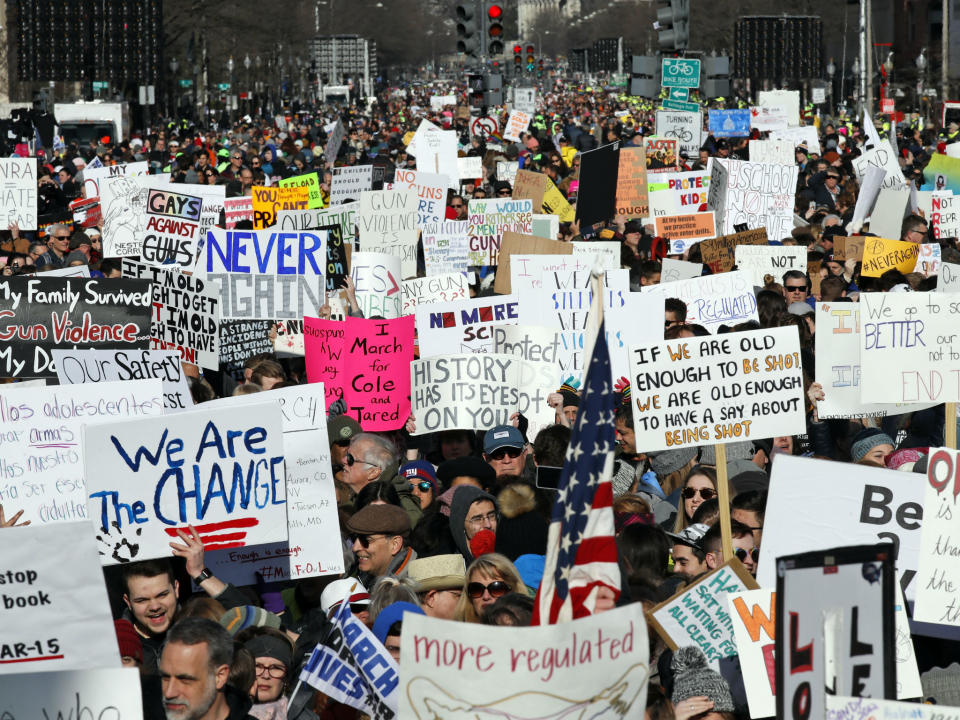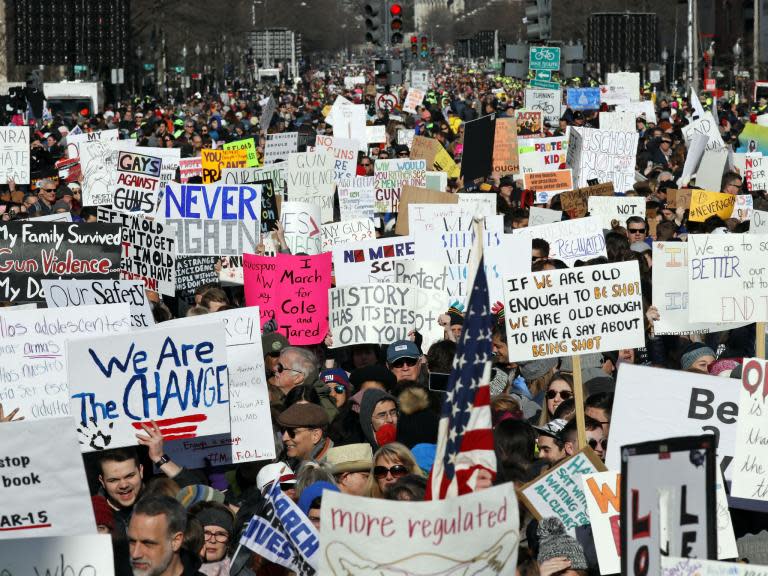March for our Lives: Parkland student Emma Gonzalez ends Washington rally by telling crowd to 'fight for your lives' - as it happened
Thirty-eight days after the massacre at Marjory Stoneman Douglas High School, hundreds of thousands of students across the country have taken to to the streets in an anti-gun violence protest of unprecedented size.
The marches – which consists of a main event in Washington DC alongside sister protests in New York, Los Angeles and hundreds of communities across the country and around the world – is the culmination of weeks of planning by student survivors of the Parkland, Florida shooting in which 17 people were killed on Valentine's Day.
The focal point was the March for Our Lives rally in Washington DC, but tens of thousands also turned out in New York, Boston, Los Angeles, Chicago, Houston and Minneapolis in demonstrations sparked by the survivors of the mass shooting at Marjory Stoneman Douglas High School in Parkland, Florida on Valentine’s Day. Beyond America – where there were about 800 events – there were protests in London, Belfast, Geneva and a number of other cities across the globe.
The marches felt like the culmination of more than a month of political pressure led by the survivors of the massacre in which 17 people were killed – including 14 students – and more than a dozen others injured. There have been some successes in that time, with some gun control measures having been signed into law in Florida, but the main message was that this was the start of something, not the end.
Cameron Kasky, one of the students who lost classmates in the Parkland shooting, told the crowd in Washington: “Welcome to the revolution.”
“[This] is the springboard that my generation and all who stand with us will use to jump to a safer future,” he said of the call for change. He said that what the students want is action on gun violence, including a federal law banning the sale of assault weapons, a law prohibiting the sale of high-capacity magazines for ammunition and universal background checks for gun sales. “Don’t worry, we got this,” he added.
Read all the updates in our live blog below. Please allow some time for the live blog to load
In the weeks since the shooting, the Parkland students have re-energised the call for gun law reform and have rejected the mantra of the powerful gun rights lobby spearheaded by the National Rifle Association (NRA) – and a number of the politicians it supports with funds – that control is not needed.
Bringing signs reading “We Are the Change”, “No More Silence” and “Keep NRA Money Out Of Politics”, protesters packed Pennsylvania Avenue between the Capitol and the White House and cheered every speaker, including Parkland student Emma Gonzalez, the leader of the student organisers, who spent six minutes in silence to illustrate the time it took for the 17 to be killed. Tears streamed down her face as she did so.
The marches across the country attracted a diverse range of protesters, young and old, as well as a cross-section of society no matter race or gender identity. Lisa Valley, 59, had come from Grove City Pennsylvania to attend the Washington DC march and praised the student leaders that had organised the rally.
“The students have inspired me about something I’ve felt strongly about for a long time… Sensible gun control is a good thing. It’s not even something we should think twice about,” she said.
Sydney Nadler, 21, came from Ohio. She told The Independent she was one of the 50 students and staff her school, Ohio Wesleyan University, sponsored to attend the event in Washington.
“I find it disturbing how our elected officials are more concerned about receiving finances to be re-elected than those who are electing them.”
The last time an event attracted so much fanfare in Washington was in January 2017, when around 500,000 people gathered in the nation’s capital for the Women’s March. That march, which took place the day after Donald Trump was inaugurated, was largely viewed as a protest against the new President. Organisers expected a similar number on Saturday, while in New York, Mayor Bill de Blasio tweeted that the March of Our Lives rally in the city today drew 175,000 people.
March for Our Lives took place as Mr Trump spent time at his Mar-a-Lago resort in Florida, almost 1,600 km (1,000 miles) away from Washington. While the White House put out a statement “applauding the many courageous young Americans” protesting across the country, Mr Trump himself was silent on Twitter about the rally as it was going on. His predecessor, Barack Obama, tweeted a message of support.
The students said they are aware change may have to come at the ballot box – on Saturday Senator Marco Rubio, a Republican from Florida commended the Parkland students and their supporters, but added that “many other Americans do not support a gun ban” and called any such move “an infringement on the Second Amendment rights of law abiding citizens”. During the afternoon there were a number of pro-gun rallies in places such as Salt Lake City in Utah, which were attended by thousands of people, but their numbers were small compared to the gun control demonstrations.
Another Parkland survivor, David Hogg, said such attitudes towards gun control may not last long. “We’re going to make sure the best people get in our elections to run not as politicians, but as Americans. Because this – this – is not cutting it,” he said, pointing at the white-domed Capitol. “We can and we will change the world!”
Wrapping up the Washington rally, Ms Gonzalez made their point clear: “Fight for your lives before it is someone else’s job.”

 Yahoo News
Yahoo News 

